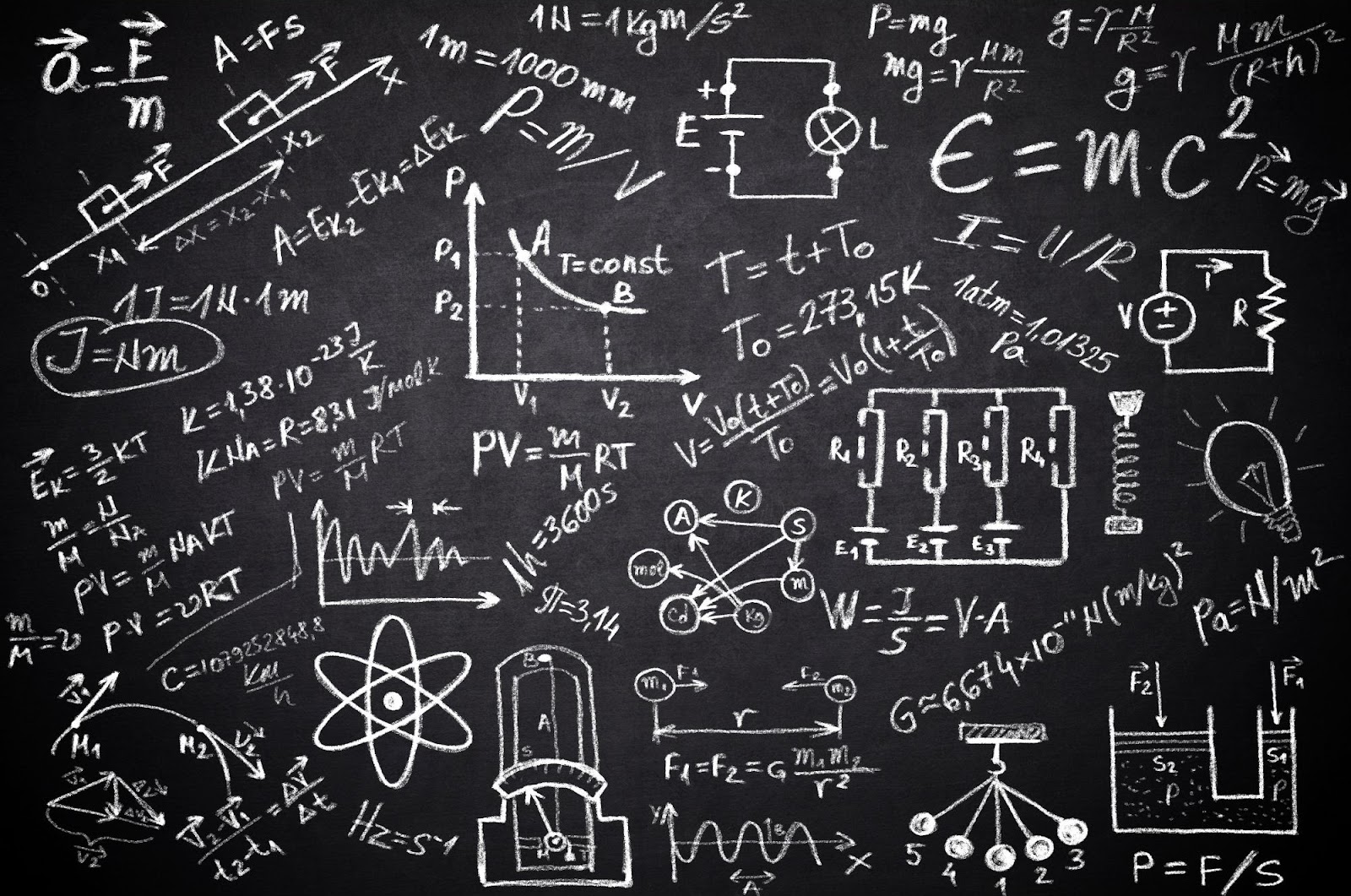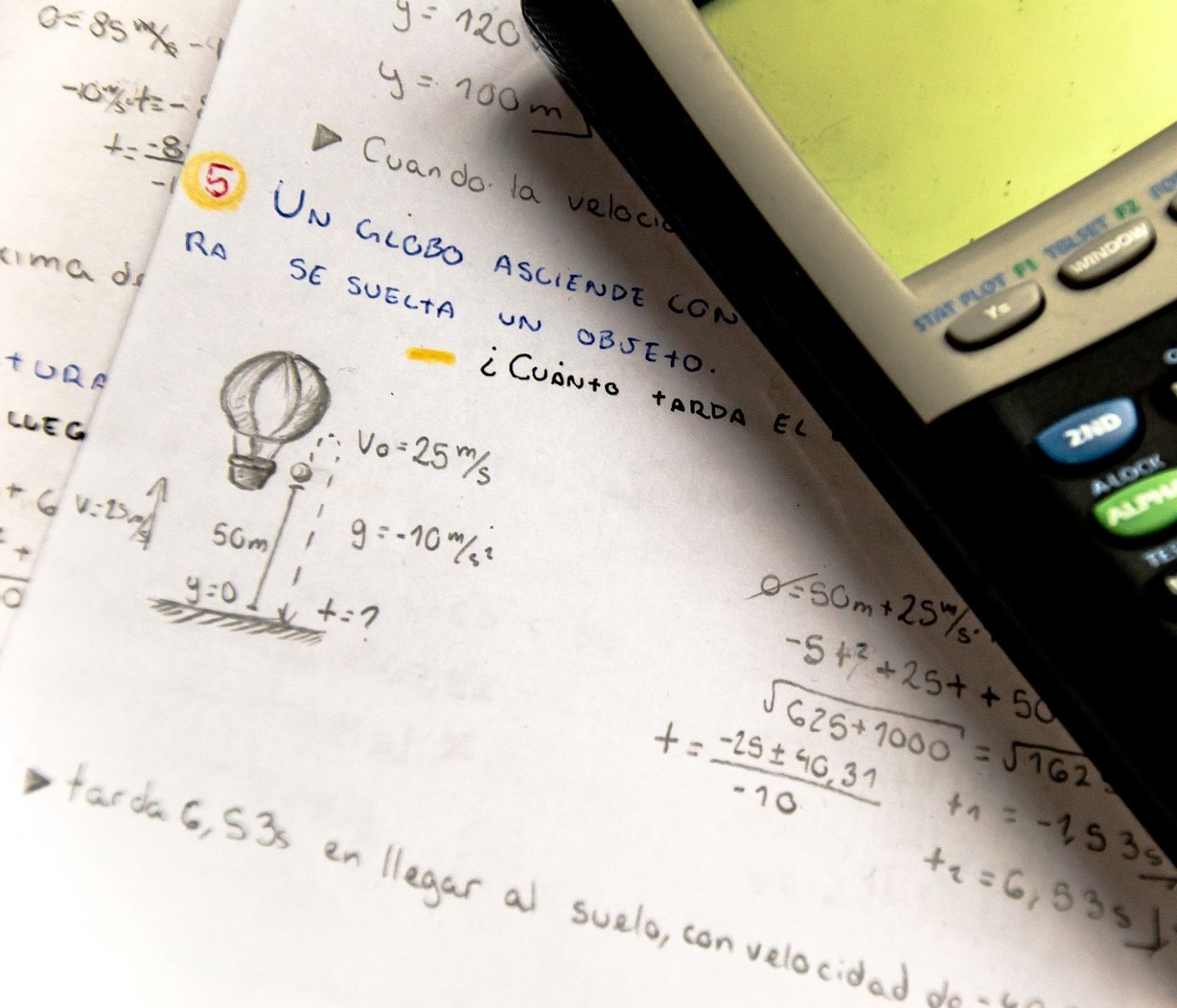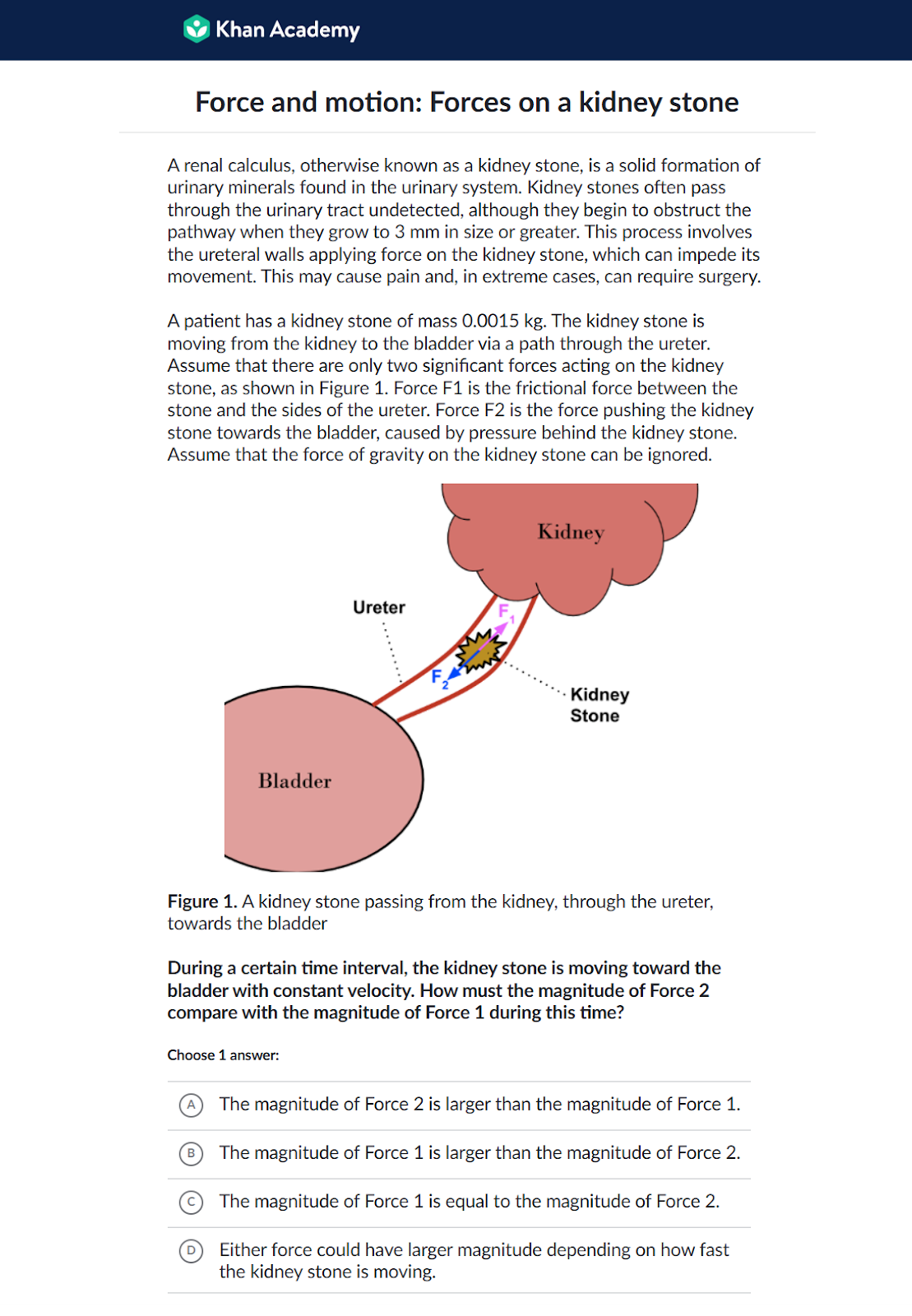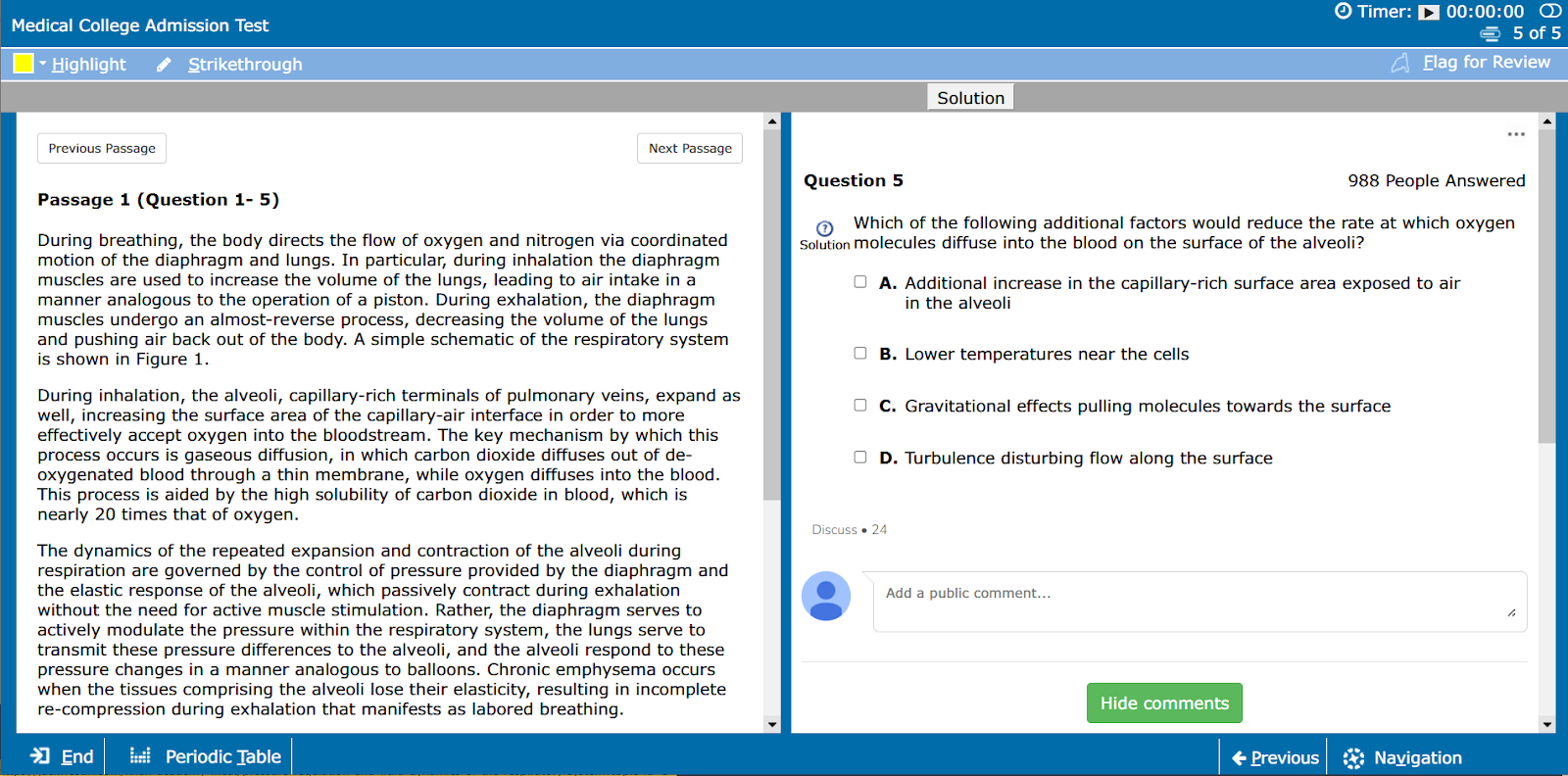Best Way to Study for MCAT Physics (According to Reddit)
By Dr. Sarah Johnson • Updated 10/6/2025
Struggling to make sense of MCAT physics? Trying to master MCAT physics concepts can feel overwhelming, time-consuming, and frustrating.
Without the right approach, it’s easy to waste hours and see little improvement.
This guide reveals the best way to study for MCAT physics, helping you simplify concepts and study efficiently, so you can effectively build your understanding and boost your exam performance with confidence and clarity.
Understanding the Physics Section Of The MCAT
The MCAT physics content is part of the broader Chemical and Physical Foundations of Biological Systems section, often called the Chem/Phys section.
This section lasts 95 minutes and includes 59 multiple-choice questions, of which 44 are passage-based and 15 are discrete questions.
Physics constitutes about 25% of the Chem/Phys section (roughly 15 out of 59 questions), focusing on foundational physics concepts and their application in biological systems.
The physics on the MCAT is generally introductory, covering material from Physics 1 coursework, but also touches on some Physics 2 topics like circuits and waves.
The MCAT physics section tests not only content knowledge but also scientific inquiry and reasoning skills, requiring test takers to interpret data, analyze experiments, and apply physics principles in medical contexts.
In summary, MCAT physics tests conceptual understanding and critical thinking, emphasizing applying physics knowledge to solve complex, biology-related problems within a timed testing environment.
How MCAT Physics Is Tested
Unlike traditional physics exams that focus on solving equations and memorizing formulas, the MCAT tests physics in an applied, conceptual, and interdisciplinary way.
Here’s how:
- Integrated into the Chem/Phys Section
Test takers must apply physics principles primarily from introductory physics courses to solve problems related to biological systems.

You’ll see physics concepts embedded in passages alongside chemistry, biochemistry, and biology (e.g., fluid dynamics in blood vessels).
- Passage-Based + Discrete Questions
Physics is tested in both formats, often requiring interpretation of experiments, data, and figures.
Don’t expect direct plug-and-chug problems. MCAT physics is about understanding and reasoning, not just solving for “x.”
- Application-Based, Not Memorization-Based
Questions are conceptual and contextual, often testing how physics applies to biological systems, like:
-
Blood flow (fluids)
-
Vision (optics)
-
Nerve signals (electricity)
-
Muscle movement (mechanics)
For example, instead of asking for a straight kinematics calculation, a question might ask: “How would increasing blood viscosity affect pressure according to Poiseuille’s law?”
- Math Skills Without a Calculator
A calculator is not allowed, so familiarity with physics equations and quick mental calculations is important.
The MCAT uses high-school and early college algebra. Expect ratios, basic trigonometry (sin, cos), and interpreting graphs. You won’t see derivatives, calculus, or integrals on the exam.
MCAT physics often rewards understanding relationships between variables, not number-crunching.
This section isn’t math-heavy. The focus is on proportional reasoning and understanding graphs/curves (e.g., reading velocities from displacement-time graphs), not complex computation.
You will typically be required to:
-
Use mental math, estimation, and dimensional analysis.
-
Rearrange equations algebraically.
-
Recognize units and cancel them logically.
-
Compare proportions rather than calculating exact values (proportional reasoning).
-
Experiment and Data Interpretation
Passages often describe experiments or real-world research.
You may need to:
-
Analyze data from tables and graphs.
-
Understand experimental setups.
-
Predict outcomes if variables are changed.
An example prompt could be: “In an experiment measuring sound wave transmission through different tissues, which variable would most likely affect intensity?”
Key Takeaway:
Overall, MCAT physics questions require more than just recalling facts; they emphasize critical thinking, data interpretation, scientific reasoning, and problem-solving skills.
The section tests four scientific inquiry skills: understanding principles, applying reasoning, analyzing research design, and making data-based inferences.
How To Master MCAT Physics
To master MCAT Physics, you need to focus on a strategic approach combining content mastery, practice, and test-taking skills.
- Know What’s Actually Tested.
Start by focusing only on MCAT-relevant physics topics (not everything from your college course).
Use the AAMC content outline or a trusted MCAT physics checklist to stay focused on the tested topics only.
- Learn the Concepts Before the Math.
The MCAT cares more about understanding relationships than crunching numbers. You need conceptual mastery, meaning you have to understand concepts before doing math.
Example: “If pressure increases in a fluid, how does flow rate change?”
Focus on:
-
Cause and effect
-
Variable relationships (e.g., “If X ↑, what happens to Y?”)
-
Visualizing what’s happening physically
- Master the High-Yield Equations.
Don’t try to memorize every formula. Instead, memorize and apply the core equations.

-
Focus on 20-30 high-yield equations.
-
Understand what each variable means.
-
Know how changing one affects the others.
Pro Tip: Practice manipulating formulas algebraically - that’s what the MCAT often requires.
- Practice with MCAT-Style Questions.
Once you know the concepts and equations, apply them with realistic practice.
You can use AAMC QBank, UWorld, or Blueprint for passage-based physics questions, and mix in discretes for quick concept checks.
Focus on:
-
Interpreting graphs and tables.
-
Applying concepts to biology-related setups (e.g., fluids in blood vessels).
-
Making quick estimations under time pressure.
- Review Mistakes Intentionally.
Every missed question is an opportunity.
Ask yourself:
-
Did I not understand the concept?
-
Did I misuse the equation?
-
Did I misread the graph or passage?
Build a “Physics Mistake Journal” to track patterns so you can analyze mistakes and review weak spots.
- Build Speed + Intuition.
Practice solving problems:
-
Without a calculator.
-
Using dimensional analysis and logic.
-
By estimating (round numbers and simplify).
The MCAT rewards quick, confident reasoning, not perfect math. Train for speed, logic, and estimation.
- Use the Right Study Resources
To master MCAT physics, use high-quality resources that focus on MCAT-style thinking, not textbook theory.
Our recommendations are:
-
UWorld: Best for realistic passage-based practice.
-
Khan Academy MCAT Physics: Free and great for conceptual review.
-
Anki Decks: For daily equation and concept reinforcement.
-
MCAT Prep Books: Kaplan, ExamKrackers, or Blueprint for structured review.
High-Yield MCAT Physics Topics
What’s actually tested on the MCAT physics exam?
The key topics include:
-
Mechanics & Energy: Kinematics (displacement, velocity, acceleration); Newton’s laws; Work & energy (kinetic/potential); Impulse & momentum; basic rotation (torque, moment of inertia).
-
Fluids & Thermodynamics: Pressure & buoyancy; fluid flow (continuity equation, Bernoulli’s principle); ideal gas law; first law of thermodynamics (ΔU = Q – W); heat/phase changes (specific heat).
-
Electricity & Magnetism (including Circuits): Electrostatics (Coulomb’s law, E-fields, potential); simple circuits (Ohm’s law, series vs. parallel resistors, RC circuits intuition); magnetic fields (force on charges, basic Lenz’s/Faraday’s ideas).
-
Waves, Sound, & Optics: Wave properties (wavelength, frequency, speed); Doppler effect; sound intensity (log scales, decibels); reflection/refraction; thin lens/mirror equations (sign conventions, magnification).
These main topics recur in nearly every test and often overlap with biology (e.g., blood flow, vision).
In practice, focus on the high-yield physics topics and get really solid on those. Don’t waste time obsessing over rare topics.
Aim for the 80/20: know the 20% of material that makes up 80% of the questions.
Pro Tip: The MCAT tests application, not just knowledge. You must apply these physics concepts to biological systems, like blood flow, nerve conduction, or eye function.
How To Learn MCAT Physics Equations
Physics on the MCAT is more about conceptual understanding than calculation. However, every concept is tied to an equation.
Many answers in the Chem/Phys section are based on equation logic. Even in verbal-style passages, answer choices often reflect:
-
Direct equation outcomes
-
Inverse/square relationships
-
Conceptual misuses of equations (to trick you!)
So, if you don’t know the needed equation, you’re more likely to fall for a trap.
You don’t just need to memorize physics equations; you need to understand, apply, and manipulate them under time pressure.
Here’s how to master physics equations the smart way:
-
Must-Know Formula List: Create a concise list of the essential physics formulas (your own cheat sheet).
-
Understand the Meaning: Don’t just memorize equations; learn what each variable represents and why the equation works.
For each equation, write down the units and a quick note on its meaning/traps.
For example: Newton’s Second Law (F=ma) (Newtons = kg·m/s²; remember the net force sign convention). Hooke’s Law (F=-kx) (force on a spring; watch the negative sign indicating direction).
-
Derive When Possible: Work through derivations to see how equations come together, which deepens understanding. But don’t waste time memorizing long derivations.
-
Group Equations by Topic: Organize equations by theme (e.g., mechanics, electricity) to see connections and reduce overload.
-
Learn “When to Use” Cues: Associate keywords with formulas. This helps cement when and how to use it.
For example, a question mentioning “accelerating mass” cues (F=ma); “distance traveled by constant force” suggests (W=Fd); “pool of water with pressure” cues (P=F/A).
- Flashcards & One-Liners: Make flashcards that force you to recall both the formula and a one-sentence concept.
For instance, a card might say “Energy of a moving object” and you recall “Kinetic energy (KE=½mv2) (units joules, J)”.
- Smart Approximations: Memorize helpful constants/approximations for mental math, and use these to get ballpark answers without a calculator.
For instance, use 10 for gravity (instead of 9.8); Use 3×108 for speed of light; Treat π≈3, etc.
Math & Units MCAT Physics Strategies
One of the biggest MCAT challenges is being able to do physics math fast, with no calculator, limited time, and weird units.
However, you don’t need perfect math to ace MCAT physics; you just need smart strategy.
Sharpen your number sense by practicing these hacks daily:
- Know your Scientific Notation: Get comfortable shifting exponents (e.g., 2×103×3×102=6×105).
Be comfortable working with scientific notation to handle very large or small numbers efficiently, without writing out many zeros.
Do quick pencil-and-paper drills to multiply/divide powers of 10.
- Key Approximations: Round numbers for speed
For example: Instead of calculating 𝐹=4.3×9.8; round to 4×10=40N
These will particularly save time on wave and sound problems.
- Think in Proportions: Instead of solving for numbers, focus on how variables affect each other.
For example: From F=ma: If mass triples and acceleration is constant, then force triples. From KE=½mv2: If velocity doubles, then KE increases by 4 times.
MCAT loves proportional logic questions, and you can often eliminate 2-3 answers without doing any math.
- Know your Logs: Memorize square roots and logs you’ll use often. These will be helpful for physics-chem crossover questions.
Key logs to know: log(1)=0 ; log(10)=1 ; log(2)≈0.3 ; log(5)≈0.7.
- Dimensional Analysis: When using a formula, always check that units work out on both sides of the calculation. This is your fastest error-catcher.
For example, if solving for energy (Joules), any answer in Watts or kg·m²/s³ is wrong.
- Tiny Constants Sheet: Make a small list of constants you use (Boltzmann’s (k), electron charge (e), etc.).
Even writing them down once before you start a Chem/Phys section can speed up conversions and checks (this is allowed on the exam).
Connecting MCAT Physics to Bio/Chem
Many students struggle with physics on the MCAT because they treat it as a completely separate subject; when in reality, the MCAT loves testing physics in biological and chemical contexts.
MCAT Physics is not just about motion and mechanics; it’s about how physics principles explain biological systems and chemical processes.
Making these connections in your studies is key to mastering physics for the MCAT.
-
Fluids ↔ Circulation/Respiration: Think of blood pressure (P=F/A) or airflow in lungs as fluid flow. Problems on resistance (ΔP = Q×R) tie into cardiac output and airway resistance.
-
Optics ↔ Vision: Photoreceptor focusing reminds us of ray diagrams. Lens/mirror problems are isomorphic to how the eye focuses light. Also, connect electromagnetic spectrum to spectrophotometry in biology.
-
Circuits ↔ Neuro: Electric circuits are analogous to neural circuits. A neuron’s resting and action potentials obey the same voltage/current principles. Simple RC circuits are similar to charging in nerve membranes.
-
Thermo ↔ Metabolism: Energy conservation links to calorimetry. Think of ΔU and heat (q) in terms of metabolic energy usage or ATP hydrolysis.
By seeing these links, physics problems will feel more intuitive (and more relevant).
Strategy: How To Make The Connection While Studying
-
Ask: “How does this apply to the body or a chemical system?”
-
Use diagrams to connect abstract concepts to real-life systems.
-
Pair topics:
-
Study fluids with cardiovascular physiology.
-
Study circuits with the nervous system or membrane transport.
-
Study optics with eye anatomy.
- Do interdisciplinary passages: Practice physics-based passages in AAMC or UWorld that also test biology/chemistry content.
An Effective MCAT Physics Practice Progression Plan
Step 1: Discrete Questions.
Start by drilling individual concept questions (like UWorld question bank problems). This builds confidence in each formula or idea. Use those to identify weakness (e.g., “my waves problems got 60% correct”).
Step 2: Timed Passages.
Once you’re comfortable with the basics, transition to multi-step passage sets. Now you practice integrating facts under time pressure. For physics, passages often include related general chem or bio context, so use those to your advantage.
Step 3: Official Practice Questions.
Go heavy on AAMC’s own resources. Early on, sprinkle in questions from the AAMC Section Bank and Question Packs (each pack has 120 questions, including a physics pack).
These come directly from MCAT content writers and are gold-standard practice. Doing them early familiarizes you with the exam style.
For structured planning around physics study, consider MCAT study plan templates to organize your prep timeline.
Step 4: Full-Length Exams.
In the last 4-6 weeks, integrate full-length Chem/Phys sections. Aim for one Chem/Phys section (59 questions) every 1–2 weeks. After each, immediately review every question, especially errors.
The AAMC even provides two free full-length practice exams and five more low-cost exams. Use these to simulate real test timing.
Throughout your practice, use UWorld (or a similarly high-value Qbank) for extra problem volume and detailed explanations. Remember to track error patterns diligently. If most mistakes are from, say, circuits, target that in your study.
Tackling MCAT Physics Passages
MCAT physics passages can look intimidating, full of experimental setups, weird graphs, and unfamiliar terms. But here’s a little trick: you don’t need to understand every detail - you just need to extract the physics.
Here’s how to approach physics passages efficiently and accurately.
Step 1: Skim & Map.
Briefly read the passage intro and question stems first. Jot a quick diagram or list of given variables (mass, velocity, charge, etc.) Identify what’s being asked.

For example, if it’s a circuit problem, draw the circuit and label resistances/voltages.
Example Circuits Question: Two resistors are in parallel vs. series, and you’re asked which branch has more current.
Without crunching numbers, recall that series R adds up (so less current flows overall), whereas in parallel, the total R is lower (more current). A quick circuit diagram and this insight often nails it.
Step 2: Translate to Relationships.
Convert words to physics concepts. If a passage mentions “doubling the radius,” think how related quantities scale (area ∝ radius²).
Often, proportional reasoning yields the answer direction without numbers.
Example Optics Question: If an object is closer to a converging lens than its focal length, you know the image is virtual (on the same side as the object).
Apply the thin-lens sign rule: (1/f = 1/d_o + 1/d_i). Plug in a negative image distance to match a virtual image. The sign alone can narrow answer choices.
Step 3: Unit & Magnitude Checks.
After you have an equation or approach, do a units check. If solving for energy, you want units of J.
Eliminate any answer whose units don’t match or whose magnitude is off by orders of 10. This alone can often eliminate 2 answers.
Example Fluids Passage: Imagine a question gives water pressure differences and asks for the force on an area.
Write (P = F/A) and plug in known pressure (in Pascals) and area (m²). Notice Pa = N/m², so (F) will come out in Newtons. You might not need a calculator to see which answer is in the 103–10**4 N range, just by unit consistency.
Step 4: Estimate & Simplify.
If the math looks nasty, use rough numbers or rounding to simplify. For example, if you see √2 in a calculation, you might use 1.4 in your head.
Check answer options for the closest match. Remember what Shemmassian Consulting advises: “Let the answer choices guide your approach on math problems.”
Don’t sweat getting a perfect decimal; get in the right ballpark.
Step 5: Skip & Return.
If a question is taking up too much time (e.g., 2+ minutes), mark it and move on. Bank the easier points first, then come back if time allows.
How To Review Your MCAT Physics Performance
Most students practice physics, but few actually know how to review effectively, which leads to repeating the same mistakes.
Practicing physics problems is only half the battle. The real improvement happens when you take time to review what you got wrong, what you guessed on, and even what you got right by luck.
You need to identify and seal knowledge gaps aggressively.
Here’s how to systematically review your MCAT physics practice using a simple error-log system:
-
Keep an Error Log: Whenever you miss a question, note the topic and the nature of the error: concept misunderstanding, wrong formula, unit/sign mistake, passage misread, or just time panic?
-
Root Cause & Rule: For each error, write why it happened and a rule to fix it. (“Forgot negative sign on acceleration - draw direction arrow on each problem.”) This turns mistakes into drills.
-
Spaced Redo: Redo missed problems a couple of days later, then again 1-2 weeks later. This spaced repetition makes sure the lesson sticks.
-
Track Patterns: Celebrate when you start acing previously weak areas. Focus new study time on the only topics still causing errors. Over time, you’ll see improvement (e.g., “I used to average 50% on waves but now 85%”).
Daily + Weekly MCAT Physics Study Routine
Consistency beats cramming, so build a simple and sustainable study routine you can stick to.
Daily: Spend 20-30 min on Anki or flashcards (equations, units, concept quizzes), then 45-60 minutes on mixed Chem/Phys practice problems or passages (with a physics focus).

3-4 Times/Week: Do timed physics passage sets (AAMC Section Bank blocks or UWorld passages).
Treat it like the actual test day by having a single-session block, 10-15 minutes per passage. Immediately after each set, review every question in detail.
Weekly: At least once a week, mix physics with your general chem/biochem study.
For example, take a mini quiz of 6-10 questions that includes a few physics questions. This simulates the actual Chem/Phys section mixing.
Remember that review time is just as important as time spent taking a quiz or test. Block off study sessions specifically for post-test or post-quiz review.
Fixing mistakes is where your score truly grows. For every wrong answer, write down exactly why you missed it and the rule you will use next time.
If you learn better with structure, you might also try sample schedules on MCATStudyPlanner’s site - it lets you customize these routines (e.g., “Chem/Phys Study Guide” timelines).
Recommended MCAT Physics Study Resources
- AAMC Official Prep - The gold standard
Use the official Physics Question Pack, question bank, Chem/Phys Section Bank, and full-length practice exams (AAMC offers two free and five low-cost full exams). These mimic the real MCAT style.
- Khan Academy MCAT
Provides access to free videos/quizzes on every physics topic, offering great conceptual review that’s backed by the AAMC.
Jack Westin runs the Khan Academy MCAT passages in test format, providing useful practice.

- UWorld’s MCAT Physics QBank
This highly rated resource has lots of practice and detailed explanations.
For supplemental reinforcement, explore Anki decks for MCAT to build long-term retention through spaced repetition.
- Quick Review Guides
Leah4Sci has concise MCAT physics review sheets.
YouTube channels like “2.5-Hour MCAT Physics” walkthroughs can be a last-minute refresher.
Common MCAT Physics Traps To Avoid
- Force-Memorizing Formulas.
Don’t learn equations by rote, without understanding their derivations or contexts. Always ask yourself why a formula works and practice applying it.
Fix: Focus on understanding how and why formulas work (e.g., conservation principles, units, and vector directions).
- Ignoring Units and Conversions.
Don’t just plug numbers into equations without checking units. Unit mismatches often signal wrong equations or misapplied concepts.
Fix: Always double-check units and use dimensional analysis to ensure your formula makes physical sense.
- Misunderstanding Direction in Vectors.
Confusing scalar vs. vector quantities (especially in motion, force, and field questions) will lead to sign errors, which can completely change the outcome, e.g., net force or acceleration.
Fix: Draw diagrams and use clear coordinate systems. Break vectors into components.
- Ignoring Underlying Concepts in Passage-Based Questions.
Some questions are best solved by conceptual reasoning rather than plugging into equations.
Don’t jump straight to equations instead of reading the passage carefully. MCAT passages often test your ability to apply physics to unfamiliar scenarios.
Fix: Focus on the why behind the scenario. Look for underlying principles (e.g., conservation laws, Newton’s laws).
- Chasing Rare Topics.
Don’t over-study things like quantum mechanics or relativity; they rarely appear on MCAT physics. Prioritize fluids, circuits, optics, kinematics, etc.
Fix: Prioritize high-yield topics based on AAMC guidelines and practice test trends.
- Mindless Question Grinding.
Doing dozens of questions without reviewing them is pointless.
Fix: Always go through every answer choice. If you got it right, ensure you did it the right way; if wrong, learn why.
- Math Anxiety.
Don’t assume that every problem is complex because it’s on the MCAT. Panic around algebraic steps will lead to you wasting time on unnecessary calculations.
Fix: Look for shortcuts and logic-based approaches before doing full computations. Practice estimating and logical shortcuts so math doesn’t scare you on test day.
High-Value Test Day Tactics For MCAT Physics
- Triage
In each passage block, quickly do the easier questions first. Mark the calculation-heavy or time-consuming ones to revisit if time allows.
- Start With a Conceptual Scan
Many physics questions test understanding, not calculation. Before diving into math, ask yourself: What’s the core principle? (e.g., Newton’s 2nd Law, conservation of energy, Bernoulli’s principle). This can often eliminate 1-2 wrong choices instantly.
Circuits Example: “Two 100 Ω resistors: one in series, one in parallel with a 100 Ω resistor, find total current if V=10 V.”
Recognize that series R (100+100=200Ω) draws less current than parallel R (1/100 + 1/100 =1/50 Ω*-1* → 50Ω).
Without detailed math, you know the parallel arrangement has lower equivalent resistance, so parallel circuit → larger current (Ohm’s law (I=V/R)).
- Round Numbers Strongly
Before plugging in, round values and do a quick mental calculation. Often, the multiple-choice answers will be separated enough that your estimate pins down the right one.
Fluids Example: “A column of water exerts 6 × 10**4 Pa on the bottom of a container. If the base is 0.5 m², what is the force?”
Quickly do (F = Pxa = 6x104Pa x 0.5m2).
Even without a calculator, knowing (1Pa=1N/m2), you see (F=3x10**4 N)
- Draw Quick Diagrams and Label Everything
Visualizing problems, especially for forces, motion, or circuits, reduces careless errors. Sketch forces, directions, and components on scrap paper. Include units and signs, and define symbols.
Optics Example: “An object is 10 cm from a converging lens of focal length 15 cm. Where is the image?”
Here (d_o < f), so the image is virtual (it’s on the same side, behind the lens).
Using sign convention, you’d plug into (1/f=1/d_o+1/d_i) and get a negative (d_i).
The key is recognizing a virtual image scenario from object placement, then choosing the answer with negative sign/direction.
- Trust Units & Magnitude
Your best check at the end of a problem: do the units match the question?
If you get 15 kg when you expected 15 N, you’ve messed up. Similarly, if your answer is too big or small, re-check your arithmetic before locking it in.
- Strategically Analyze the Answer Choices
Sometimes, the structure of the answers gives away the method needed. Check for patterns like:
-
All answers in terms of variables? → Likely an algebraic setup.
-
Close numerical values? → Need precise math or estimation.
-
Opposite directions/signs? → Vector or force direction at play.
Conclusion
You don’t need to love physics to do well on the MCAT; you just need a system and practice.
Master the core topics (don’t worry about obscure details), learn equations with meaning (know when and why to use them), drill daily practice passages, review mistakes thoroughly, and boost your mental math skills.
Ultimately, MCAT Physics rewards students who:
-
Have a conceptual understanding of physics principles.
-
Can apply physics principles in unfamiliar contexts.
-
Know when and how to apply core equations.
-
Can interpret data and experimental design.
-
Can think critically under time pressure.
-
Can make smart approximations and spot relationships.
For extra help, MCAT Study Planner offers a free custom study plan tool.
You can build a personalized schedule (including physics study!) that fits your timeline and keeps you accountable. Try it out to keep your physics prep on track.
Good luck - you’ve got this!
For complementary skills development, explore MCAT CARS study approaches to enhance your critical analysis abilities alongside physics mastery.
Written by
Dr. Sarah Johnson
Last updated 10/6/2025
